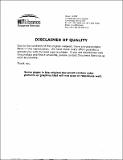Dynamic actuation properties of Ni-Mn-Ga ferromagnetic shape memory alloys
Author(s)
Henry, Christopher P. (Christopher Paul), 1974-
DownloadFull printable version (11.77Mb)
Alternative title
Dynamic actuation response of Ni-Mn-Ga ferromagnetic shape memory alloys
Other Contributors
Massachusetts Institute of Technology. Dept. of Materials Science and Engineering.
Advisor
Samuel M. Allen and Robert C. O'Handley.
Terms of use
Metadata
Show full item recordAbstract
Dynamic magnetic-field-induced strain actuation of up to 3% with a frequency bandwidth of least 500 Hz in Ni48.5Mn29.5Ga21 ferromagnetic shape memory alloys (FMSAs) is achieved. Hardware was designed and constructed to measure frequency bandwidth, magnetic-field-induced strain, stress and magnetization driven from an applied magnetic field. The bandwidth in this investigation was only limited by inductive reactance of the hardware, not by fundamental limitations of Ni-Mn-Ga. Degradation of the peak dynamic actuation strain occurred from 3.0% to 2.6% with increasing number of cycles from Nz1,000 to N 100,000. Measurement of strain, stress, and magnetization driven by a magnetic field permitted the comparison of measured properties versus properly defined thermodynamic properties. The peak thermodynamic piezomagnetic coefficient is d3, 1,= 2.5 x 10-7m / A compared to the experimental slope, dE/dH, of 1.0 x 10-7 m / A at N-1,000 cycles and 1.4 x 10-7 m / A at N-100,000 cycles, respectively. The thermodynamic piezomagnetic coefficient is five times greater than Terfenol-D with d31 = 5.0 x 10-m / A. The magnetic susceptibility varies between 3-10, while the twinning stiffness varies between 30-40 MPa within the average bias stress range of 0.3 to 2.8 MPa. At optimum fields and bias stresses, the mechanical energy density during cyclic deformation was 65 kJ/m3 at the expense of 20 kJ/m3 lost An important first observation of dynamic stress vs. field behavior is understood by an extension of a magnetomechanical phenomenological model. (cont.) The mechanism of stress generation is thought to be magnetization rotation causing negative magnetostriction with quadratic magnetic-field dependence before twin boundaries move. Above the threshold field for twin boundary motion, stress increases in proportion to the magnetic-field-induced strain. Dynamic actuation measurements performed here help put Ni-Mn-Ga FSMAs into perspective with other active materials performance: Ni-Mn-Ga FSMAs are between low bandwidth, high strain, Nitinol and high bandwidth, low strain Terfenol-D and ferroelectrics.
Description
Thesis (Ph.D.)--Massachusetts Institute of Technology, Dept. of Materials Science and Engineering, 2002. Includes bibliographical references (leaves 198-201).
Date issued
2002Department
Massachusetts Institute of Technology. Department of Materials Science and EngineeringPublisher
Massachusetts Institute of Technology
Keywords
Materials Science and Engineering.